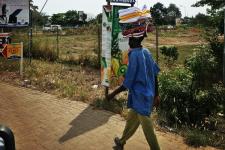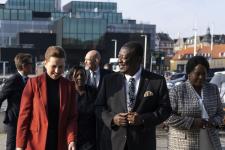African migration – key tendencies and political dilemmas

Migration is an integral part of local livelihoods in many places of Africa. Migrants move to provide for their families, for education, religious purposes, security, to establish a better future, for family reasons and much more. Most migration takes place within countries, often from rural areas or smaller towns to larger urban areas or cities. Less migration is international, primarily directed at the neighbouring countries while migration towards Europe is relatively limited. Out of the approximately 1.4 billion people that constitutes Africa’s population, there are about 43 million international African migrants, mostly living in the country of origin, primarily in neighbouring countries and region. Europe, North America and Asia are the main settlement continents outside the continent.
Both regular and irregular migration constitutes key issues for Danish and European political agendas with consequent dilemmas. These are intrinsically linked to ongoing structural transformations, such as changing geopolitics, trade, conflict, the demographic transition, and climate change, at times deepening global and regional inequalities. Below three key tendencies and ensuing dilemmas are outlined, with emphasis on possible areas of political collaboration or contestation from Danish (and more broadly European) and African perspectives.
THREE KEY TENDENCIES
Circular labour migration
Migration and development are closely connected in African contexts, due to the scale of remittances, skills transfer and diaspora investment. Yet, many African migrants do not set out to settle in Europe or elsewhere but wish to live in their country of origin, if and when personal and overall circumstances have improved. Circular migration understood as returning to home or moving onwards to another location – and possibly re-migrating – is thus a normal practice in many contexts. This situation has potential for African-European collaboration. With prospects of a shrinking labour force and already existing shortages of, e.g., tech professionals, nurses, and care and farm workers, the demand for migrant labour in Europe and elsewhere can be expected to rise in the coming years. Due to demographic changes, this tendency will likely be more pronounced as Europe is projected to have low birth rates and an ageing population while populations on the African continent will continue growing and consist of predominantly young people. The impetus for promoting and engaging in regular and circular migration may thus be a shared political ambition, as un- and underemployment continues to affect many (young) Africans.
Climate change
Rising temperatures and extreme weather are playing a growing role in shaping displacement, including forced immobility. Yet, alarmist scenarios predicting millions of African migrants heading towards Europe in response to climate change are not substantiated by research. Rather, most climate-related migration occurs within countries, especially to neighbouring areas and urban centres. However, it does not affect everyone equally, as the impact of climate change, including food insecurity, disproportionally affects poor people in developing countries. Forced immobility – that people cannot move despite their need or desire to do so – is another central, if somewhat ignored, problem.
Development agencies increasingly acknowledge the potential adaptive role migration may play. Yet, what constitutes successful adaptation, under which conditions and for whom, remains challenging to establish. It is also difficult to discern how and to what degree migration is caused by climate change, particularly in relation to slow-onset environmental changes with gradually rising temperatures and irregular participation. Rather, climate change constitutes a compounding driver of migration that may intensify existing mobility patterns. Whether this will change, if large areas of the African continent become unhabitable and uncultivable, remains to be seen.
Border control and restrictive migration regimes
Finally, border control and the regulation and deterrence of third country migration more generally has been a political concern in Europe at least since the creation of the Schengen area, with increased importance from 2015. In addition to domestic concerns of integration challenges, this mirrors a fear that migration entails a security threat. As a result, African and other third country migration has become securitized with restrictive immigration and asylum legislation as well as strengthened border control at national and EU borders. Outsourcing and externalization of migration control to and in African sending and transit countries is a key trend as well, with readmission of rejected asylum and irregular migrants to their countries of origin as a consistent priority. An implication is that access to safe and legal migration to Europe, including for protection, is out of reach for many if not most African nationals. In turn, a minority turns to irregular means of migration – often dangerous and costly, with human rights violations, including extortion, kidnapping, torture and loss of lives in the Sahara Desert or in the Mediterranean Sea. The limited access to safe and legal migration constitutes a public and political concern in sending and transit countries, widely perceived as unfair and unsustainable.
DILEMMAS AND STRATEGIC CONCERNS
As a cross-cutting, high profile and, at times, and highly symbolic issue in Danish and African political contexts alike, how Denmark (and other European countries) handle migration becomes part of a larger framework of interpretation for African leaders. This makes engagement with migration delicate, with possible spillover effects that could stand in the way of other political issues.
Creating legal pathways for circular migration is a potentially shared political priority, relating to the rubric of safe, orderly and regular migration in the Global Migration Compact. Ideally this works for migrants and destination countries alike. In practice, there are several dilemmas. With growing competition and demand for skilled labour, brain drain is a potential problem, as emigration of doctors, nurses, engineers or other professionals may deplete countries of needed skills and deepen inequalities in terms of health care etc, thereby contributing to global and local inequalities. Supporting education and training in selected sectors, be it tech or health, would be important, also given the youthful and growing African population.
Additionally, the construction of legal pathways must take several issues into consideration to avoid creating a new (or maintaining an existing) migrant labour precariat. Ensuring proper employment and salary conditions as well as smooth skills recognition is pertinent so that migrants can work within their fields of expertise and maintain – perhaps upgrade – their competencies, rather than experiencing de-skilling. This can be further supported by long-term and flexible work permits with opportunities for traveling back and forth, rather than short-term and ‘locked’ migratory movement which comes with the risk of irregularity and exploitation when they terminate. Finally, work permits should be relatively simple to obtain and inexpensive to avoid leaving migrants and their families in debt and dependency on brokers.
Migration management and readmission agreements where African countries accept rejected asylum seekers and migrants are, as mentioned above, an important priority for Danish and EU political leaders. Conditionality – that links acceptance of such agreements with the possibility for, e.g., trade deals, development aid or egal pathways - is an often-used political tool to promote this agenda. This is a contentious issue in many African countries where politicians – just like in Denmark – need to deal with domestic issues and expectations of their constituencies. While funding of socioeconomic reintegration support mechanisms to returned migrants may be on the table in negotiations, such projects tend to be short-lived and fail to bring durable solutions. Likewise, they are probably of a relatively low political priority. Hence, they may not ‘add up’ in relation to other aspects of migration politics where practices of deportations of Africans and restrictive migration regimes may be perceived as politically unfair and humiliating.
Long-term implications of migration policies are thus an important deliberation, as European and African leaders make agreements on regulating, deterring and controlling migration. In such cases, migrants constitute a diplomatic bargaining chip that is engaged by both sides of the table, for instance through African countries amping up border control in return for military or coastguard support, or other incentives. Such agreement come with risks, however, as governments may also threaten to relax border control, using Europe’s fear of uncontrolled migration as political leverage or as a means of signalling new geopolitical alliances. Niger is a current example. Furthermore, externalization of border control through supporting military and police may constitute de factor support to anti-democratic forces that can backfire in the long run, with negative impacts on Danish and European interests. This is a critical dilemma in the face of a changing geopolitical landscape and growing anti-western sentiments.
Rapid urbanization in the face of climate change and population growth is perhaps one of the biggest migration related challenges regarding climate change for African policymakers, with concomitant pressures on infrastructure, housing, energy supply, and other aspects of urban planning. Likewise rural-to-urban migration is perceived as a potential social and economic problem in some African countries. As international migration is often preceded by internal movements to larger cities, this may have indirect if long-term implications for the broader policy area of migration. A strategic concern – spanning several programming silos – relates to supporting urban transformations in relation to adaptation and the green transition so that cities and urban areas are better prepared to managing migration and population growth in general and in particular in relation to climate change.
Recognizing migrants as a resource constitutes a final strategic concern. Remittances are pertinent in many African countries where migrants’ contributions have poverty reducing effects for their families and constitute lifelines during crises, such as drought, conflict, and instability. Likewise migrant engagement in development and humanitarianism at the collective level plays an important role, not least in conflict-affected areas. Such practices may come with considerable expectations to and pressures on migrants though. Furthermore, some African political and economic elites have migrant experiences and/or are closely connected with their families, constituencies, or businesses abroad, being engaged in political lobbying, and diaspora investment, development and diplomacy. Engaging and consulting with diaspora groups constitutes a small if important step that may have long-term positive implications in a continuously more connected world.
DIIS Experts


